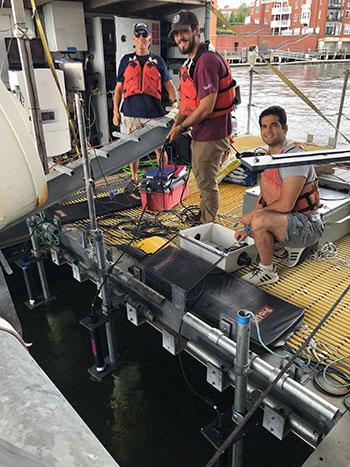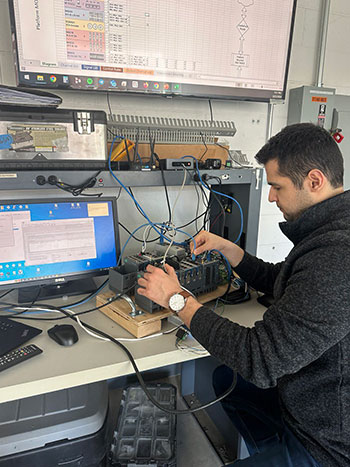How Two Rookie Engineers Expertly Designed a Tidal Energy Turbine
The Turbine Will Collect and Share Data To Deepen Our Understanding of Tidal Energy

Doctoral student Mason Bichanich reviews and troubleshoots tidal turbine data at the University of New Hampshire’s Turbine Deployment Platform. Photo from Nicole Marone, UNH
To innovate in marine energy requires some extracurriculars: turning wrenches at the barge, conducting trial runs in the wave pool, and talking through ideas with a supportive team.
All this appeals to University of New Hampshire (UNH) doctoral candidates Parviz Sedigh and Mason Bichanich because it is progress toward creating their first real-world device, a hydrokinetic turbine that will teach the world about tidal energy.
Before this project, neither student had seen their work in the water. But in partnership with the National Renewable Energy Laboratory (NREL), Sandia National Laboratories, and the Pacific Northwest National Laboratory (PNNL), and with funding from the U.S. Department of Energy’s Water Power Technologies Office, they designed an axial-flow tidal turbine that is fully instrumented to collect data at the mouth of the Piscataqua River in New England.
Using NREL’s Modular Ocean Data Acquisition (MODAQ) setup, their turbine will supply highly useful data for the nascent field of tidal energy, a clean energy source with enough technical potential to power up to 21 million homes in the United States. The country cannot harness all that power—some must be reserved for fishers, boaters, and other water denizens—but even a small portion could go a long way in helping the United States achieve its clean energy goals.
Their 25-kilowatt turbine—about the size of a harbor seal and oriented like an underwater wind turbine—will be on triple duty once deployed. Besides producing valuable data, it will help power a busy drawbridge and support community education through UNH’s Living Bridge Project. All it took was diving headfirst into an unknown field.
Waves of Uncertainty

Project Engineer Ken Lannamann, Bichanich, and Sedigh (left to right) test turbine components at UNH’s turbine deployment platform. Photo from Jon Hunt, UNH
Neither Sedigh nor Bichanich knew what to expect when engineering an axial turbine, but their excitement for creating something new propelled them ahead. Bichanich, a hands-on type, came to the project with a degree in environmental engineering, a lifetime around lakes, and a proclivity for mechanical tinkering.
Growing up in a somewhat remote Midwestern town, Bichanich has always been an engineer, “and definitely not in the professional sense,” he said. Whenever his friends’ cars broke down, Bichanich would head to the local scrapyard to scavenge. “The quickest way to find out how a part works is by holding it in your hands,” Bichanich said.
Bichanich and his mentor, Martin Wosnik, were working through the new turbine design for nearly two years when Sedigh joined the team.
Sedigh brought a special competence. His master’s degree in aerospace engineering taught him how propulsion systems work in a different fluid: air. Ready for something new, he took a leap to the denser field of marine energy.
“Interest in aerospace engineering comes from my childhood,” Sedigh said. “Whenever I saw an airplane, I wanted to know how such a giant machine could fly. I wanted to learn the principles behind that. Generating electricity using water is an extension of aircraft engines, and the axial-flow tidal turbine shares many similarities in principle, so I wanted to learn more.”

Sedigh works on the data acquisition controls that were integrated into the “living” tidal turbine. Photo from Parviz Sedigh, UNH
But for this turbine, the project team would depart from past builds. Sedigh and Bichanich needed their turbine to sense and collect data. It would have to protect many sensor types, along with their wiring and controls, all while powering small loads and dodging debris in the turbid estuary, before the Piscataqua meets the Gulf of Maine. If successful, they would deliver original data to the Living Bridge project and to a global research community.
“I’ve never built anything that’ll be this important,” Bichanich acknowledged. “It can be challenging working on something brand new, but it’s always fulfilling to see the parts you’ve designed be made and hold them in your hands.”
Sedigh harbors similar wonder at the professional engineering process, having “only worked with ideas in previous projects.”
Ready or not, the team had to start somewhere. They picked through a conceptual scrapyard of past designs, drawing inspiration when possible or adding a unique spin when necessary. “We couldn’t pull one-to-one from past designs because of scale: Sometimes the costs don’t make sense,” Bichanich explained.
Collaborating closely with NREL, PNNL, and Sandia, the team eventually settled on a viable 3D model. All that remained was fabrication and physical assembly, which has been wrapping up in 2024.

The axial-flow tidal turbine will collect operational data and power the Memorial Bridge in Portsmouth, New Hampshire. Rendering by Mason Bichanich, UNH
Better Data To Enhance the Living Bridge
The new turbine is slated for initial testing this year in Portsmouth, New Hampshire, beneath the Memorial Bridge, which was rebranded as the Living Bridge by the Atlantic Marine Energy Center (AMEC) to promote its role as a pillar of public science. It is a destination for students and citizens to interact and familiarize themselves with the power electronics attached to the bridge’s piles, helping to educate and excite the public about tidal energy.

Bichanich, Wosnik, Sedigh, and Lannamann, pose with the nose cone of the new turbine at UNH’s Jere A. Chase Ocean Engineering Laboratory. Photo from Andressa Gutierrez, UNH
Compared to a prior research turbine beneath the bridge, the incoming turbine is technologically unique in that it is highly instrumented to collect as much data as possible. The kernel of this data acquisition is NREL’s MODAQ, which contains open-source software for logging performance data. MODAQ simplifies the publishing and sharing of data, which can be presented at Portsmouth’s Living Bridge.

Beneath the Living Bridge, researchers and students interact with and learn about tidal energy. Photo from Martin Wosnik, UNH
“With this project, NREL is sharing its past experience and technological skills with AMEC and its students in the hopes that the Living Bridge platform can be used for future turbine testing and education,” said Aidan Bharath, project lead at NREL. “Bichanich and Sedigh are building the foundation of a research platform that will allow future turbine components to be tested and comprehensively monitored.”
Data from the MODAQ system will be openly available through the Water Power Technologies Office’s Marine and Hydrokinetic Data Repository. Besides tracking strain on the turbine, power output, and environmental conditions, equipment such as PNNL’s acoustic camera will also watch upstream for floating perils and collect data on tidal debris. “We got hit by a lobster pot the other day,” Bichanich mentioned, also noting the dangers of fallen trees and bobbing icebergs.
Installation Imminent
For Bichanich and Sedigh, the remaining work is mostly defined—things like cable routing and instrument testing. Obviously, there is nothing trivial about submerged electrical components, but as the team approaches the finish line, they recognize how important close collaboration has been.
“Sedigh and I are each turning the wrench as much as the other,” Bichanich said.
“One person can come up with an idea, but two of us can try and multiply the idea to get an optimized outcome,” Sedigh added.
As their first professional engineering achievement, the turbine will forever be a special project, and both researchers plan to keep it close.
“Sedigh and I are going to have an attachment to anything that we put on that platform. And since we built it, we’re going to be the best suited to work on it,” Bichanich said.
Learn more about NREL's marine energy research. And subscribe to the NREL water power newsletter, The Current, to make sure you do not miss a water power update.

